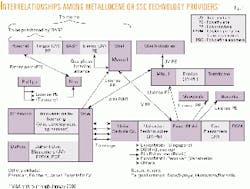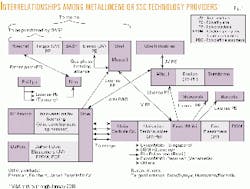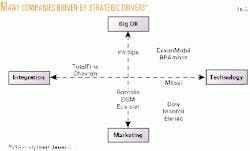The changes under way in the polyolefins industry are having dramatic implications on producer competitiveness and technological development.
The combination of industry consolidation and recent intellectual-property resolutions in metallocene and single-site catalysts (SSCs) has altered the playing field. These two changes underscore the importance of technological capabilities and access.
Investors favor companies that combine production scale and technological scope as industry leaders. They expect related growth and investment returns from these firms.
Companies that are not leaders are relegated to the role of follower and are forced to seek partnerships and alliances or become targets for mergers or acquisitions.
Industry consolidation and the resolution of catalyst intellectual-property disagreements have made strategic decisions for polyolefin producers more straightforward.
Prior to these recent significant events, polyolefin companies made many decisions in an environment characterized by fierce competition and high levels of uncertainty. The uncertain environment had especially profound effects on technology availability (licensing), product evaluation (market acceptance), and competitor positioning (strategy).
As a result of polyolefin industry changes, several newly emerging strategic drivers may have ongoing long-term impacts on company competitiveness:
- The push toward consolidating technological positions in both catalyst and process patent estates (that is, the knowledge within the patents themselves).
- The need to establish proper balance between commodity and specialty resins.
- The drive to extract maximum value and return through market participation.
Leaders involved in metallocene technologies, like ExxonMobil Corp., Dow Chemical Co., and BASF AG (via Elenac and Targor) have already taken actions to implement these drivers.
For example, the pending combination of Dow and Union Carbide creates an enterprise with annual revenues greater than $24 billion, a market capitalization of $35 billion, and assets worth more than $30 billion.
BASF and Shell's joint venture, awaiting approval from the US Federal Trade Commission, will combine Montell NV, Targor, Elenac GmbH, and Elenac SA into one of the largest polypropylene and polyethylene producers in the world.
To date, other polyolefin companies have either failed to act or have done so without achieving the necessary critical levels in scale or scope. Fig. 1 depicts major companies with their metallocene or SSC-related agreements. Double-sided arrows denote joint ventures and alliances, and single-sided arrows denote licenses.
Limited future technologies
Metallocene or SSC-catalyst technologies that have been proven commercially will increasingly dominate licensing considerations over potentially robust, yet less proven alternatives. These catalyst options will receive an increasing percentage of financial backing and marketplace promotion at the expense of developing alternative technologies.
Thus, the trend towards consolidation of large players will likely extend technological refinement preferentially over funding for large-scale novel technological innovations.
Refinements will take the form of improved process economics, increased catalyst predictability, and enhanced product specifications. Enhanced specifications include co-monomer incorporation, chain-branching characteristics, and polymer morphology.
Structural change, namely producer consolidation, affects intellectual property positions in two ways (Fig. 2): more comprehensive "scopes of control" and enhanced "scales of influence."
In technological "scopes of control," complementary capabilities are combined to provide advantages that were previously unattainable or unrecognized. These advantages may take the form of improving competitive position (through expanded offerings) or raising entry barriers for competitors (through prohibitive costs or limitations on access).
In technological "scales of influence" that arise from consolidation, companies with strong technology positions are able to limit, if not outright determine, the licensing scope of their competitors using the technology.
This enhancement to competitive position can provide a significant, if not commanding, advantage in the marketplace. In certain cases, both the volume and sophistication of competitive offerings are largely predetermined by the technology owners.
The advantages provided by "scales of influence" can take the form of minimizing competitive offerings or controlling key resources necessary to compete.
These resources may be both physical resources, such as catalyst or cocatalyst supplies, or more likely, they may be intangibles, such as technological resources. Resources include synthetic methods or intellectual capital, including patent properties.
Consolidation may lead to closer supervision over those technologies that become available and over the applications where they may be used. As a result, the size and composition of the companies that are permitted access may be more carefully monitored.
The result is a competitive landscape which is much more dynamic and depends upon the activities of the leaders. As well, the competitive hurdles for companies that are either slow or unable to develop technological advantages may be elevated, forcing them to seek partnerships or become acquisition targets.
Fewer players
Through consolidation and alliance tactics, producers will be able to apply more control to the choice of available technologies that enable resins to serve market needs. Producers that are able to "balance" the correct technology choice to meet the requirements of the market will benefit the most.
These consolidation tactics are also a way to avoid expensive litigation between feuding parties. Such alliances increase the competitive hurdles for the average resin producer, which will continue to precipitate future alliances as a defensive measure.
With the new alliances and industry settlements, there seems to be a better selection of available technologies and new products that will meet evolving market needs.
The structural changes arising in the polyolefin industry are a result of competitors' attempts to build sufficient critical mass, in terms of size and technology strength, and to improve their competitive positions.
During the past 5 years, the industry has seen more than 10 major polyolefin company names disappear as a result of consolidation. Disappearances include Amoco, Himont (and soon Montell), BASF, Hoechst, Lyondell, Millennium, Occidental, Mobil, Neste, Fina, Elf, and soon Union Carbide.
The new industry structure has resulted in larger players who have garnered greater market share, while reducing per unit overhead costs. Reduced overhead costs, such as R&D and sales, is one way to attempt to improve overall profitability.
In summary, characteristics of the new competitive landscape resulting from consolidation are:
- Fewer, but larger players.
- Control of technology by only a few.
- Larger market share for surviving participants.
- Improved global reach for companies.
- Broader offering of products and services.
- New revenue sources from licensed technologies.
Because competitive strength and value in the polyolefins business come from a variety of strategic practices, future structural change will likely mimic the practices that are core to each participant.
The Catalyst Group has developed a new millennium structural framework, depicted in Fig. 3, to view the polyolefin industry based on identifying the strategic drivers each participant uses to create value.
In seeking ways to participate, many competitors may favor more than one of these drivers. The closer a company is to a single driver (and offers something which is differentiating), the more likely it may be to find a partner that practices different drivers within the framework.
Technology, markets, competition
The changes underway will affect not only technologies and materials, but markets and competitors as well.
Producer consolidation and patent-dispute resolutions will affect technologies in the following ways:
- Companies that had previously remained committed to Ziegler-Natta systems are now more free to consider competitive (and available) metallocene technologies.
- The drive to circumvent the intellectual property held by Dow, Exxon, and Univation has become less intense. As a result, initiatives by the "followers" to commercialize non-metallocene SSCs (beyond the better-known materials like DuPont's diimines or BP's Fe(II) and Co(II) systems) may be delayed.
- Although internal development remains an attractive alternative for many, a larger number of companies may now commence discussions with the leaders regarding access to patent technologies and assurances of freedom to operate with these technologies.
Consolidation of companies and patent-dispute resolutions affect materials and markets in several ways:
- Resin evaluations and metallocene-based polyolefins incorporation into commercial products will proliferate. Dow, ExxonMobil, BP, Chevron Phillips Chemical Co., and soon to be Basell (Elenac, Targor, and Montell) are the primary beneficiaries.
- Since the settlement of the metallocene catalyst patent dispute between Dow, ExxonMobil, and Univation in June 18, 1999, the further exploration of the technology, to produce additional novel materials using the technology, has become more attractive to these leaders.
- Other leading technology development companies face stiffer competition in the new, more open, environment.
- Resin processors and fabricators will likely change development and evaluation methods to take full advantage of newly available opportunities.
Competitors may need to reassess current strategies as consolidation and patent-dispute resolutions change companies:
- Dow, Exxon, and Univation's settlement has removed restrictions in evaluation and use and includes an agreement to license certain rights. These actions clearly alter the range of alternatives for those without metallocene technology.
- Licensing, in some form, now becomes a viable strategy for entry into the metallocene-based polyolefins market. The decision in which Phillips was found "not liable" for infringing Exxon's US 5,324,800 patent is largely responsible for this lowered entry barrier.
- The settlement may alter the manner in which competition takes place, including strategic considerations like competitor identity, product-development cycles, and investment-return expectations.
- Ongoing, internal development of competitive technology is worth revisiting, as costs mount and demands on financial returns increase.
It is against this background of structural change and consolidation, as well as rapid technological innovation, that producers currently compete. Many methods to achieve viability, even prosperity, will be implemented, but all will be based on meeting end-user needs in ways which distinguish one from its competitors.
The authors-
John J. Murphy is program director at Catalyst Group. He develops and conducts technical and market research in the polymers industries. He specializes in analyses of metallocene and other single-site organometallic catalysts and the polymers derived from them.
Prior to joining Catalyst Group, Murphy was senior associate at DRI/McGraw-Hill, where he analyzed petrochemical and polymer demand trends and assessed impacts of intermaterial competition, policy implementation, and prices using econometric modeling.
Murphy holds an AB degree in chemistry and the romance languages from Bowdoin College in Brunswick, Me. He also holds an MBA from Lehigh University in Bethlehem, Pa.
Howard R. Blum is vice-president of Catalyst Group. His fields of expertise include polymers and polymer catalysts, including metallocenes and Ziegler-Natta systems. He is involved in assessing technology trends that will impact polymer use, cost, and performance affecting competitive dynamics and strategy. Blum also has a broad experience in petrochemicals and specialties.
Prior to Catalyst Group, he was a partner at Chem Systems Inc., Tarrytown, N.Y., and worked for Conoco Chemicals.
Blum holds an AB degree in chemistry and biological sciences from Miami University in Oxford, Ohio and an MBA from Fairleigh Dickinson University in Teaneck, N.J.
Clyde F. Payn is CEO of Catalyst Group. He works with clients to develop and implement technology and business strategies. Payn founded Catalyst Consultants Inc.(CCI) in 1984, the forerunner of Catalyst Group.
Prior to forming CCI, Payn was business manager of catalyst recovery for Johnson Matthey Inc.
Before joining Johnson Matthey, Payn was technical manager for Carborundum's New Zealand subsidiary as well as technical service, marketing and sales positions in the company's International and US operations.
Payn holds an NZCS degree in chemistry from the Auckland Technical Institute, New Zealand, and an MBA from Vanderbilt University, Nashville.




